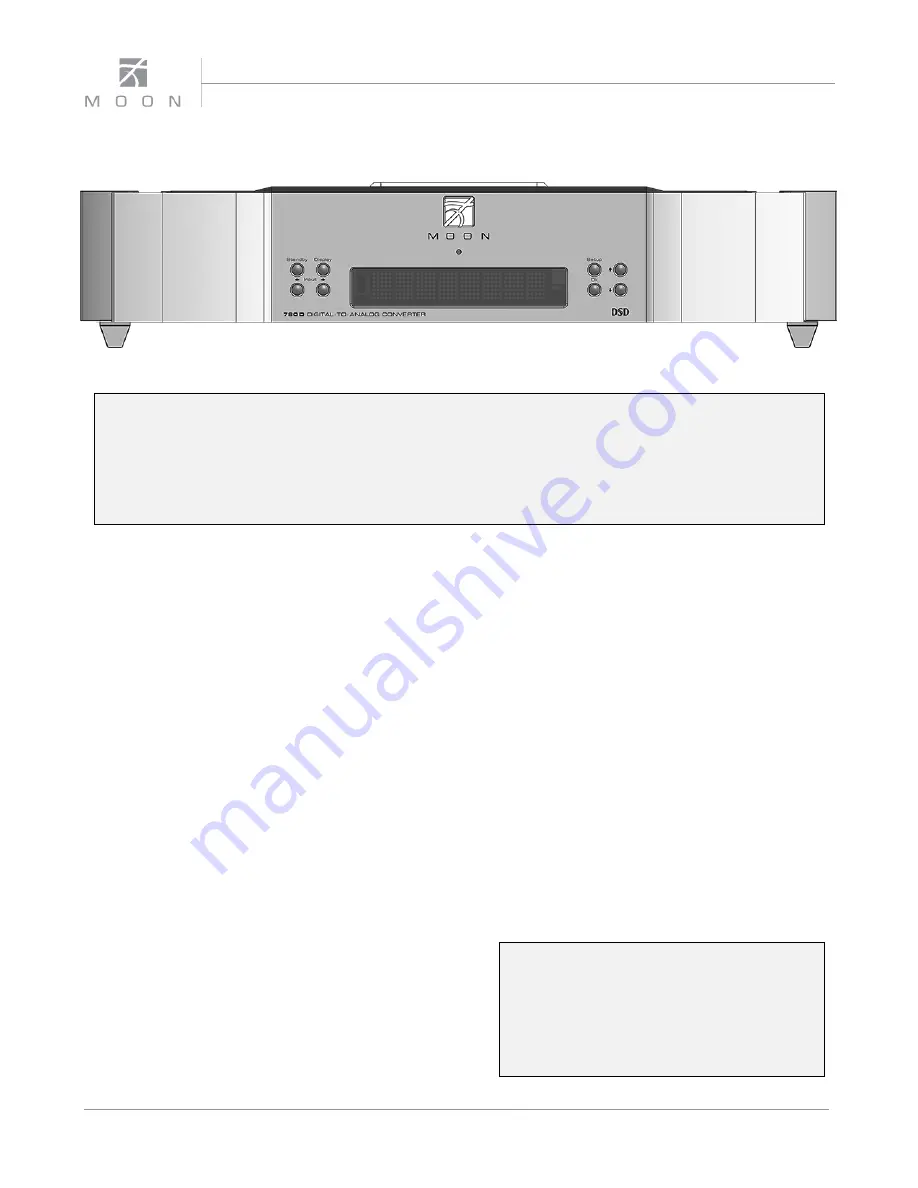
780D Evolution
Series
Front Panel Controls
Figure 1: 780D Front panel
The front panel will look similar to Figure 1 (above). The large digital display window indicates the selected digital
input (“D1” thru “D9”) its corresponding sampling rate frequency in kHz (“44.1” thru “384.0”) of the source material
currently being played and/or assigned input label. The “Standby” button disengages all outputs from the rest of
the
780D’s
circuitry and turns off the digital display. However, when in “Standby” mode, all digital and analog
audio circuitry remains powered up to help maintain optimal performance. When switching back from “Standby”
to the “on” mode, the selected ‘input’ will be memorized from the previous listening session. The blue indicator
LED turns off when the
780D
is in “Standby” mode.
The “Display” button allows you to adjust the brightness
of the large digital display window. It also provides you
with the option of turning off the display. There are
three (3) different levels of brightness; The default is
medium. Pressing the “Display” button once will
increase the level to the highest setting. Pressing the
button again will decrease the brightness to the lowest
setting. Pressing the “Display” button a third time
returns the display to its default setting of medium. To
turn the display off, press and hold the “Display” button
for 2 seconds. When the display is turned off, it will still
come back on briefly whenever you press any of the
buttons located on the front panel or the remote
control, using the brightness level that was previously
set; the display will automatically turn off again once
you are done. To turn the display back on, simply press
and hold the “Display” button for 2 seconds.
The two (2) buttons labeled “
◄
Input
►
” allow you to
sequentially scroll, either forward “
►
” or backward “
◄
”
through all the digital inputs. The inputs are ordered as
follows going forward: “D1”, “D2”, “D3” , “D4” , “D5” ,
“D6” , “D7” “D8” and “D9”. When you change inputs, the
display window will show the new digital input and
briefly four (4) dashes “----”. These dashes indicate that
the
780D
is in the process of locking onto a digital
signal – this may take several seconds. Once the
780D
successfully locks onto the digital signal, the four dashes
will be replaced by either the sampling rate frequency
of this digital signal or the assigned label for this input
(refer to the next section “Software Setup” for further
details). When the selected digital input signal cannot
be locked onto, “----” remains in the display window.
The
780D
is capable of processing a PCM digital signal
at one of the following eight (8) different sampling
rates: “44.1”, “48.0”, “88.2”, “96.0” , “176.4” , “192.0” ,
“352.8” and “384.0” (all in kHz) or a DSD digital signal at
one of the following three (3) data rates DSD64
(2.82MHz), DSD128 (5.64MHz) and DSD256 (11.28MHz);
For DSD input signals, the corresponding information
will appear in the display window as “DSD” , “DSD.2”
and “DSD.4” for these data rates, respectively.
The “Setup” and “OK” buttons are used for
programming the numerous software functions
available on this DAC. The next section, entitled
“Software Setup”, explains their usage in detail. As well,
the
▲
and
▼
buttons are used to navigate through the
“Software Setup” menus.
Notes: (i) DSD format signals can ONLY be
played through the USB (“D7”) input and the
MiND’s ethernet (“D8”) input - The MiND input
is limited to DSD64. (ii) PCM format signals with
sample-rates of 352.8kHz and 384kHz can
ONLY be played through the USB (“D7”) input
and the MiND’s ethernet (“D8”) input.
8
Содержание 780D evolution series
Страница 1: ...780D Evolution Series Reference Streaming DSD DAC Owner s Manual...
Страница 2: ...780D Evolution Series...




















